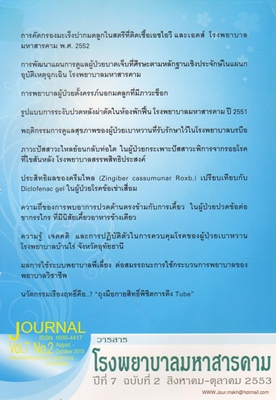ประสิทธิผลของครีมไพล (Zingiber cassumunar Roxb.) เปรียบเทียบกับ diclofenac gel ในผู้ป่วยโรคข้อเข่าเสื่อม
คำสำคัญ:
โรคข้อเข่าเสื่อม, ครีมไพล, ความสามารถในการทำกิจกรรมบทคัดย่อ
วัตถุประสงค์ : เพื่อศึกษาผลการใช้ ครีมไพล เปรียบเทียบกับการใช้ diclofenac gel ในการลดปวดในผู้ป่วยโรคข้อเข่าเสื่อมในระดับรุนแรงน้อยถึงปานกลาง
รูปแบบการวิจัย : การศึกษาเชิงการทดลองแบบสุ่ม มีกลุ่มควบคุมและผู้ประเมินไม่ทราบว่าผู้ป่วยอยู่ในกลุ่มใด (experimental randomized single blinded controlled trial)
วิธีการศึกษา : สุ่มเลือกผู้ป่วยโรคข้อเข่าเสื่อมออกเป็น2 กลุ่ม กลุ่มที่ 1 ได้รับการรักษาด้วยครีมไพล และกลุ่มที่ 2 ได้รับการรักษาด้วย diclofenac gel โดยให้ทาวันละ 3 ครั้ง และนวดเบาๆ 30 วินาที ทุกวัน บริเวณที่มีอาการปวด เป็นเวลา 4 สัปดาห์ ประเมินผลการรักษาด้วยระดับความรู้สึกปวดของผู้ป่วยโดยรวมโดยใช้ visual analog scale (VAS) และความสามารถในการทำกิจกรรมต่างๆ โดยใช้ Modified WOMAC scale เปรียบเทียบระหว่างก่อนการศึกษาและติดตามประเมินซ้ำในสัปดาห์ที่ 2 และ 4
ผลการศึกษา : มีผู้ป่วยเข้าร่วมการศึกษาจำนวน 22 คน เป็นกลุ่มครีมไพล 12 ราย และ diclofenac gel 10ราย เมื่อเปรียบเทียบข้อมูลพื้นฐานของผู้ป่วยทั้ง 2 กลุ่ม พบว่าไม่มีความแตกต่างอย่างมีนัยสำคัญทางสถิติที่ p < 0.05 ครีมไพลมีประสิทธิผลดีกว่า diclofenac gel ในการลดความปวดและเพิ่มความสามารถในการทำกิจกรรมต่างๆ เมื่อประเมินด้วย VAS และ Modified WOMAC scale ระหว่างสัปดาห์ที่ 0-2 และสัปดาห์ที่ 0-4 อย่างมีนัยสำคัญทางสถิติที่ p < 0.05 ขณะที่ไม่พบผลข้างเคียงใดๆ จากการใช้ครีมไพล
สรุป : ครีมไพลมีประสิทธิผลในการลดความปวด และเพิ่มความสามารถในการทำกิจกรรมต่างๆ ได้ดีกว่า เมื่อเปรียบเทียบกับการใช้ diclofenac gel
เอกสารอ้างอิง
อุทิศ ดีสมโชค. การดูแลรักษาโรคข้อกระดูกเสื่อม.ใน: อุทิศ ดีสมโชค, มนาธิป โอศิริ, บรรณาธิการ. การดูแลรักษาผู้ป่วยโรคข้อและรูมาติซั่ม. กรุงเทพ: โรงพิมพ์พีเคโปรมิเนนท์; 2548: หน้า178-93.
Goldburg MH. Epidimiology of osteoarthritis: Osteoarthritis diagnosis and management. Philadelphia: W.B.Saunders company; 1988: p 403-23.
William J, Harry W. Management of Osteoarthritis: A Textbook of Rheumatology. Philadelphia:W.B.Saunders company;1994: p 2169-99.
ศศิธร วสุวัต. การศึกษาผลทางเภสัชวิทยาของน้ำมันไพล ZINGIBER CASUMUNAR BOXB: การประชุมวิชาการวิทยาศาสตร์และเทคโนโลยีแห่งประเทศไทย ครั้งที่10, กรุงเทพ; 2527: หน้า 218-9.
Pongprayoon U, Tuchinda P, Claeson P, et al. Topical antiinflammatory activity of the major lipophilic constituent of the rhizome of Zingiber cassumunar, Part 2 . Phytomedicine 1997; 3(4): 323-26.
Ghatak N, Basu N. Sodium curcuminate as an effective antiinflammatory agent. Indian J Exp Biol 1972; 10: 235-6.
Srimal RC, Dhawan BN. Pharmacology of diferuloyl methane (curcumin), a non-steroidal anti-inflammatory agent. J Pharm Pharmacol 1973; 25(6): 447-52.
Mukhopadhyay A, Basu N, Ghatak N, Gujal PK. Antiinflammatory and irritant activities of curcumin analogs in rats. Agents Actions 1982; 12(4): 508-15.
Rao TS, Basu N, Siddiqui HH. Anti-inflammatory activity of curcumin analogs. Indian J Med Res1982; 75: 574-8.
Kunchandy E, Rao MNA. Oxygen radical scavenging activity of curcumin. Int J Pharm 1990; 58(3): 237-40.
Deodhar SD, Sethi R, Srimal RC. Preliminary study on anti-rheumatic activity of curcumin (diferuloyl methane). Indian J Med Res 1980; 71: 632-4.
Satosar RR, Shah Shenoy SG. Evaluation of antiinflammatory property of curcumin (diferuloyl methane) in patient with postoperative inflammation. International J Clin Pharmacol, Toxicol 1986; 24(12): 651-4.
Wasuwat S, Soonthornsarathoon P, Boonkong P, et al. The pharmacological study on Nam Man Phlai, Zingeber cassumuna Robx . Symposium on Science and Technology of Thailand, 10th Chiangmai, Thailand; 1984: A 79.
Wasuwat S, Nandhasri P, Suntorntanasat T, Rojjanapothi W. Antiinflammatory action of Plai oil, Zingiber cassumunar Roxb. The First Princess Chulabhorn Science Congress, Bangkok, Thailand, Dec 10-13; 1987.
Panthong A, Kanjanapothi D, Niwatananum V, Tuntiwachwuttikul P, Reutrakul V. Antiinflammatory activity of compounds isolated from Zingiber cassumnar. Planta Med 1990; 56: 60.
Panthong A, Kanjanapothi D, Niwatananant W, et al. Anti-inflammatory activity of compound D {(E)-1-(3,4-dimethoxyphenyl) but-3-en-2-ol} isolated from Zingiber cassumunar. Phytomedicine 1997; 4(3): 207-12.
ทวีศักดิ์ สุนทรธนศาสตร์ และคณะ. ไพลเจล: การวิจัยและพัฒนาเป็นยาทาภายนอกสำหรับต้านการอักเสบอย่างครบวงจร. การสัมมนาแนวทางการพัฒนาสมุนไพรของประเทศไทย, กรุงเทพฯ, 13-14 กันยายน 2543; 2543: 289-91.
Laupattarakasem W, Kowsuwon W, Laupattarakasem P, et al. Efficacy of Zingiber cassumunar ROXB (Plygesal) in the Treatment of ankle sprain. Srinagarind Med J 1993; 8(3): 159-164.
Jeenapongsa R, Yoovathaworn K, Sriwatanakul K, et al. Anti-inflammatory activity of DMPBD, a phenylbutanoid from Zingiber cassumunar. Annual research abstacts and bibliography of non-formal publications 1994, Mahidol University 1995; 22: 327.
Ar-Reum H, Moon-Sun K, Yeon H J. Cyclooxygenase-2 inhibitory phenylbutenoids form the rhizomes of Zingiber cassumunar. Chem Pharm Bull 2005; 53(11): 1466-68.
Alman R, AscheE, Block D, et al. Development of criteria for the classification and reporting of osteoarthritic classification of OA of the knee. Arthritis Rheumatism.1991;18,27:10-12.
Schinitzer TJ, Weaver AL. Efficacy of rofecoxib, celecoxib, and acetaminophen in patients with osteoarthritis of the knee. A combined analysis of the VACT studies. J Rheumatol 2005; 32(6): 1093-105.
Harvey E. 1; Moskowitz, Roland W. Analgesic efficacy and safety Of nonprescription doses of naproxen sodium compared with acetaminophen in the treatment of osteoarthritis of the knee. American Journal of Therapeutics 2004; 11(2): 85-94.
เสก อักษรานุเคราะห์. Modified Womac Scale for knee pain. J Thai Rehabbili2000; 9 :82-8
ทวีสิน ตันประยูร. ประชากรและตัวอย่าง. ใน: ภิรมย์ กมลรัตนกุล, มนต์ชัย ชาลาประวรรตน์, ทวีสิน ตันประยูร, บรรณาธิการ. หลักการทำวิจัยให้สำเร็จ. กรุงเทพ: เท็กซ์ แฮนด์ เจอร์นัล พับลิเคชั่น จำกัด; 2542: หน้า27.
ดาวน์โหลด
เผยแพร่แล้ว
รูปแบบการอ้างอิง
ฉบับ
ประเภทบทความ
สัญญาอนุญาต
วารสารนี้เป็นลิขสิทธิ์ของโรงพยาบาลมหาสารคาม






